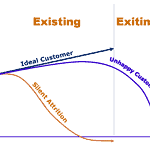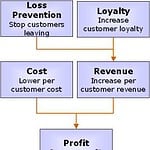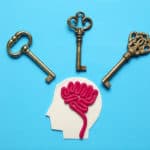“If you strip away all the hype around how to ‘do’ relationships, you are left with one simple concept. The real essence of a relationship is simply a memory of past interactions.” [1]
Learning is at the heart of customer loyalty management and has been ever since the empirical work of Reichheld [2] (and others) in the early 1990’s showed that customer loyalty is directly related to corporate profits. Learning about customers and remembering them is central to the task of managing customer relationships.
Looking back all that way to the pre-Net Promoter Score primordial haze; Reichheld found 3 loyalty effects, each highly correlated with profitability,
- Customer Loyalty
- Employee Loyalty
- Shareholder Loyalty
The relationship between Customer and Employee loyalty is particularly relevant to loyalty management success, though it takes a longer term view of customer value.
Reichheld wrote that the profit rich relationship between long term employees and loyal customers is a virtuous and self-supporting one; long term employees serving the same customers, over time grow to learn each other’s needs and preferences and establish a self improving relationship.
Just as long term friends and couples begin to intuitively accommodate each other and do not have to repeat their preferences endlessly, good companies learn and remember their customer’s needs and wants and what happened last time we talked.
If the critical ability is to learn customer needs and remember interactions, think for a moment what it means to the customer relationship when we do not know in the branch what our customer did with the call centre yesterday or on the web last night.
This is the same behaviour as a colleague who recognises you at the office but ignores you in the bar, and forgets every third conversation you have with him. It is impossible to have a positive relationship with such a person, or a company that behaves in the same way.
What should you remember?
Some simplistic thoughts on the requirements for good service “memory”; firstly, the learning process should focus on those attributes of the customer that relate to profit. This includes;
- actual and potential values of the customer, together called the customer’s life time value. This helps you select the investment that should be made with each customer.
- propensity of the customer to respond to your various marketing tools and channels. Knowing this customer “inclination to collaborate” helps reduce waste. ‘Response propensity models’ take time to build, especially if you have not implemented a campaign automation platform, so do not throw away any old campaign response data.
- typical behaviour of the customer; generally the number and time between transactions, the size of the transactions.
- financial risk; the likelihood that this customer will cost you money.
You should also learn the things that are important to the customer;
- Knowing customer needs allows you to deliver the most valuable of all relationship values, relevance. Customer relevant marketing is more effective, less wasteful and strengthens relationships as it demonstrates you have remembered what customers have been telling you.
- Their preferred channel of service and communication and (importantly) what the customer considers to be good service. Not all customers want personal attention, some prefer it. One size does not fit all in service any more than it does in product design or marketing.
It is during service interactions that the most learning should occur, especially since customers rate reliability as the most important factor in good service. Reliability is about keeping service and product promises and builds trust, a prerequisite for positive relationships.
It is here that Transactional NPS helps make sure your processes are implementing what you know your customers are expecting you to remember.
[1] Greenberg , P. “CRM at the Speed of Light” quoting Michael Simpson. McGraw Hill 2002









